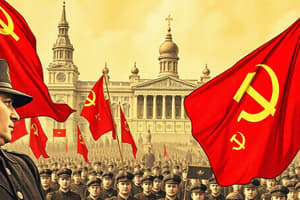Podcast
Questions and Answers
Who led the Bolshevik Revolution in Russia in 1917?
Who led the Bolshevik Revolution in Russia in 1917?
When did the Bolshevik Revolution take place in Russia?
When did the Bolshevik Revolution take place in Russia?
Which army fought against the Red Army during the Russian Civil War?
Which army fought against the Red Army during the Russian Civil War?
Who established the Communist Party as the ruling party of the USSR after the Bolshevik Revolution?
Who established the Communist Party as the ruling party of the USSR after the Bolshevik Revolution?
Signup and view all the answers
Which era is known for the process of collectivization in Russia?
Which era is known for the process of collectivization in Russia?
Signup and view all the answers
When did the Russian Civil War take place?
When did the Russian Civil War take place?
Signup and view all the answers
During Stalinism, what were the main goals of Stalin's Five-Year Plans?
During Stalinism, what were the main goals of Stalin's Five-Year Plans?
Signup and view all the answers
What was a significant negative consequence of Stalin's regime during Stalinism?
What was a significant negative consequence of Stalin's regime during Stalinism?
Signup and view all the answers
What was the primary reason behind the policy of collectivization in the Soviet Union?
What was the primary reason behind the policy of collectivization in the Soviet Union?
Signup and view all the answers
During the Cold War, what was the major ideological conflict between the Soviet Union and the United States?
During the Cold War, what was the major ideological conflict between the Soviet Union and the United States?
Signup and view all the answers
What were some consequences of collectivization on rural areas in the Soviet Union?
What were some consequences of collectivization on rural areas in the Soviet Union?
Signup and view all the answers
Which period fundamentally shaped global politics with conflicts such as the Korean War and Vietnam War?
Which period fundamentally shaped global politics with conflicts such as the Korean War and Vietnam War?
Signup and view all the answers
Study Notes
Communism in Russia
Communism, as an ideology that advocates a classless society with common ownership of property and workers' self-management, has had a profound impact on Russia since it was first introduced by Vladimir Lenin and his Bolshevik Party during the October Revolution in 1917. Here is a brief overview of communist Russia from the Bolshevik Revolution through the era of Stalinism, the Russian Civil War, the Soviet Union during the Cold War, and the subsequent process of collectivization.
Bolshevik Revolution and Aftermath
The Bolshevik Revolution began when revolutionary forces led by the Bolsheviks overthrew the Russian Provisional Government on October 25, 1917 (November 8, 1917 according to the Gregorian calendar) in what is known as the October Revolution. This event marked the end of the Russian Empire and ushered in the era of the Soviet Union. The new government took power under the leadership of Vladimir Lenin, who established the Communist Party as the ruling party of the USSR.
Russian Civil War
The Russian Civil War, which lasted from 1918 to 1921, followed the Bolshevik Revolution and saw the Red Army fight against various White armies, anarcho-syndicalists, and other anti-Soviet groups. Despite initial setbacks, the Red Army eventually triumphed, establishing the Soviet Union as a unified state following the collapse of Tsarist rule.
Stalinism
During the period of Stalinism, which lasted from the late 1920s until Stalin's death in 1953, Joseph Stalin became the leader of the Soviet Union. Under his regime, industrial growth was achieved, but it came at great human cost. Millions were sent to labor camps, executed, or died of starvation during periods of forced collectivization. Stalin's Five-Year Plans aimed to rapidly modernize industry and agriculture, leading to significant improvements in infrastructure and living standards. However, these efforts also resulted in the deaths of millions due to famine, mass deportations, and widespread repression.
Cold War
In the post-World War II era, the Cold War between the Soviet Union and its Western allies fundamentally shaped global politics. From this period emerged a series of tense geopolitical conflicts, including the Korean War and Vietnam War, as well as numerous proxy wars around the world. During the Cold War, the Soviet Union sought to spread communism beyond its borders and opposed Western capitalist expansion; meanwhile, the United States and its allies sought to contain the spread of communism.
Collectivization
Under the policy of collectivization, which was introduced in 1929 and completed within three years, all agricultural lands were nationalized, and small farms were consolidated into collective farms. Collectivization's main objective was to create large peasant cooperatives that would increase efficiency and productivity in agriculture while eliminating private enterprise. It led to widespread resistance among peasants, causing rural areas to become war zones.
In conclusion, the history of communism in Russia spanned several decades and had both positive and negative impacts on the country. While it brought about rapid economic development and political upheaval, it also caused immense suffering and loss of life due to policies such as collectivization and Stalinism.
Studying That Suits You
Use AI to generate personalized quizzes and flashcards to suit your learning preferences.
Description
Test your knowledge of communism in Russia from the Bolshevik Revolution to Stalinism and the Cold War era. Explore key events such as the Bolshevik Revolution, Russian Civil War, Stalin's regime, the Cold War, and the process of collectivization.




